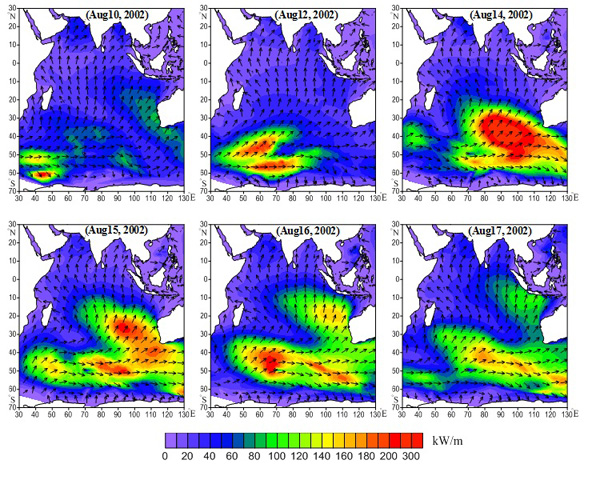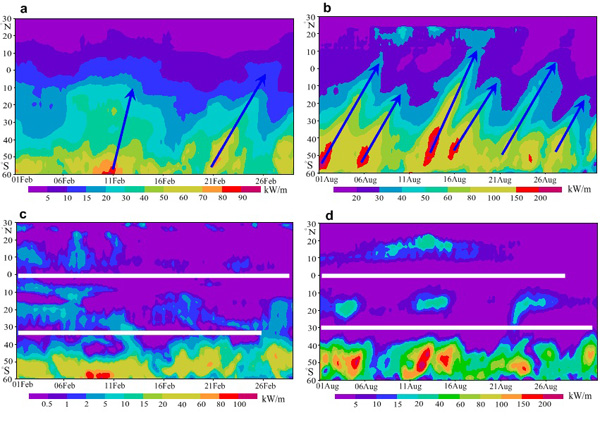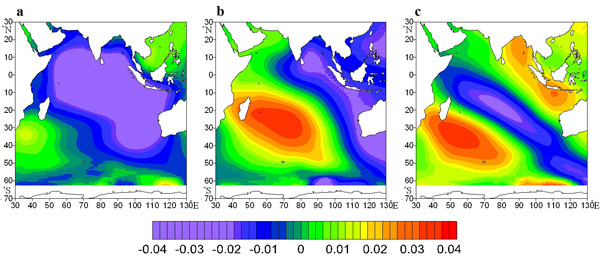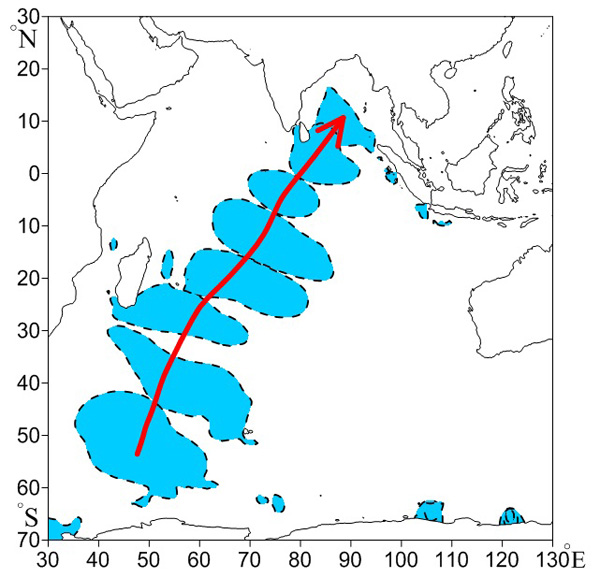State Key Laboratory of Numerical Modeling for Atmospheric Sciences and
Geophysical Fluid Dynamics (LASG)
Institute of Atmospheric Physics, Chinese Academy of Sciences

Vol. 4/No.4 December 2017
[Climate Dynamics] Propagation characteristic and intraseasonal oscillation of the swell energy of the Indian Ocean
Highlights
A method is proposed to exhibit the propagation characteristic of swell energy.
The propagation route, speed, terminal target and intraseasonal oscillation of swell energy in the Indian Ocean is exactly calculated and depicted as a case study.
Swell energy in the west of the southern Indian Ocean westerly (SIOW) generally spreads to two regions: Sri Lankan waters and Christmas Island waters, which needs about 6 days. Swell energy propagates faster during June–September than in other months.
Swell energy in the west of the SIOW, in the Sri Lankan waters, and in the Christmas Island waters share a common period of quasi-weekly oscillation.
Swell can be surprisingly destructive in the actual ocean; it can lead to phenomena such as hogging and sagging that can cause serious damage to ships. The enormous energy potential and good stability of swell also make it a new focus for wave power generation, and as an important regulator of global climate change swell also plays a key role in air-sea interactions. Previous researchers have made great contributions to the analysis of swell propagation characteristic. However, the study on the exact propagation route and speed and intraseasonal oscillation of swell energy is relatively rare.
Recently, Academician Li Chong-yin (LASG, Institute of Atmospheric Physics) and his student Dr. Zheng Chong-wei (Dalian Naval Academy) proposed a new approach to exhibit the exact propagation characteristic of swell energy. And the propagation route, speed, terminal target and intraseasonal oscillation of swell energy in the Indian Ocean are exactly calculated and depicted as a case study, by combining the leading and lagging correlation coefficients (CC), empirical orthogonal function (EOF) and wavelet analysis.
The results show that the Indian Ocean swell energy has an obvious but fluctuating northeastward propagation. The swell energy of the southern Indian Ocean westerly (SIOW) usually apparently spreads to two regions: the main body propagates in a NE–NNE direction to the Sri Lankan waters, while a small branch propagates to the Christmas Island waters, which needs about 6 days. And the swell energy propagates faster during June–September than in other months. Swell energy in the SIOW, in the Sri Lankan waters, and in the Christmas Island waters share a common period of quasi-weekly oscillation. The results play a positive role in the swell power generation, ocean wave forecasting, disaster prevention and reduction, analysis of air-sea interaction and climate change, etc. We also hope this work can make positive contribution to the construction of the 21st Century Maritime Silk Road.
This research findings have been published in Renewable and Sustainable Energy Reviews, Applied Energy, and Applied Ocean Research.

Figure 1. Swell wave power density and swell wave direction of a strong swell field process generated by southern Indian Ocean westerly in August 2002.

Figure 2. The 6-hourly zonal average values of the swell wave power density (a–b) and wind-sea WPD (c–d) in February 2002 (left) and August 2002 (right).

Figure 3. First three modes of EOF analysis of 6-hourly swell wave power density in JJA 2001.

Figure 4. Propagation route of swell energy of the southwest Indian Ocean in JJA 2001.

Figure 5. Cross-wavelet analysis between swell wave power density in regions SIOW and Sri Lankan waters (a), and between swell WPD in regions SIOW and Christmas Island waters (b) during JJA 2001.
Citation:
Zheng Chong-wei, Li Chong-yin. Propagation characteristic and intraseasonal oscillation of the swell energy of the Indian Ocean. Applied Energy, 2017, 197: 342–353, doi: http://dx.doi.org/10.1016/j.apenergy.2017.04.052
Download: http://dx.doi.org/10.1016/j.apenergy.2017.04.052
Zheng Chong-wei, Li Chong-yin. Analysis of temporal and spatial characteristics of waves in the Indian Ocean based on ERA-40 wave reanalysis. Applied Ocean Research, 2017, 63: 217–228, doi: http://dx.doi.org/10.1016/j.apor.2017.01.014
Download: http://dx.doi.org/10.1016/j.apor.2017.01.014
Zheng Chong-wei, Wang Qing, Li Chong-yin. An overview of medium- to long-term predictions of global wave energy resources. Renewable and Sustainable Energy Reviews, 2017, 79: 1492–1502, doi: http://dx.doi.org/10.1016/j.rser.2017.05.109
Download: http://dx.doi.org/10.1016/j.rser.2017.05.109
Contact:
Li Chong-yin, lcy@lasg.iap.ac.cn; Zheng Chong-wei, chinaoceanzcw@sina.cn
E-mail: lasg_newsletter@lasg.iap.ac.cn
Editors: Chuanyi Wang (wangcy@lasg.iap.ac.cn), Kangjun Chen(ckj@lasg.iap.ac.cn)